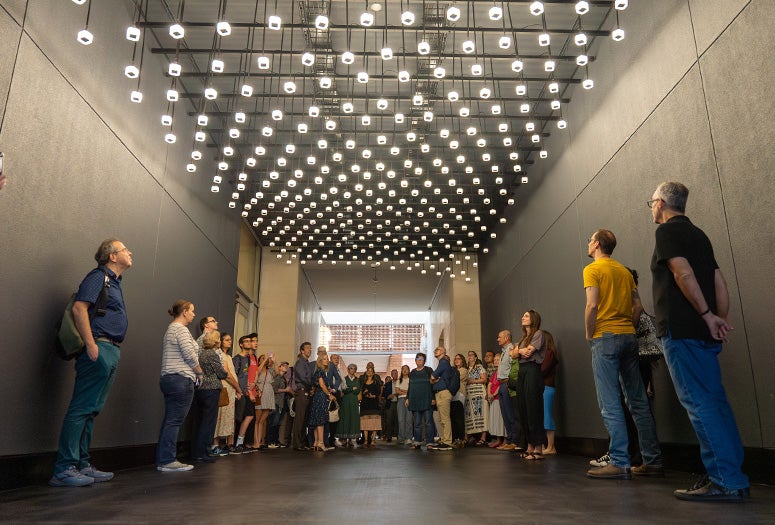Rice University’s O’Connor Building for Engineering and Science now houses an immersive public art installation titled “Climate Parliament,” a thought-provoking work by Mexican-Canadian artist Rafael Lozano-Hemmer. Commissioned by Rice’s Moody Center for the Arts for the Rice Public Art collection, the interactive artwork engages visitors with a dynamic experience that addresses the growing global climate crisis.
Sited in the exterior hallway on the north side of the O’Connor Building, “Climate Parliament” consists of 481 pendant speaker-lights, each playing unique recordings from climate activists, scientists and scholars. The voices capture a wide array of perspectives on climate change, blending personal testimonies with scientific data. As visitors walk along the corridor, their movement activates the lights and speakers, creating what Lozano-Hemmer describes as a ripple effect.
“Think of it almost as a pool that we’re sharing, then different people are creating their own waves and the water can get turbulent,” Lozano-Hemmer said. “It’s kind of like a cave of sound, almost like Plato’s cave.”
Lozano-Hemmer emphasized the diversity of voices within the installation, noting the inclusion of local Houston residents and experts.

“There are people who have, in the first person, suffered the impact of climate change through hurricanes, floods or droughts,” Lozano-Hemmer said. “Houston may be a location where a lot of the petrochemical industry was born and thrives, but it’s also the place where a lot of the really forward-thinking about how to survive in a warming planet can happen.”
For Rice faculty, the installation’s multidisciplinary approach resonates deeply. Anthropology professor Dominic Boyer, whose voice is included in the work, reflected on the power of “Climate Parliament” to curate hundreds of voices and perspectives on climate change.
“I think it’s a subtle piece that’s playing the long game in terms of public perceptions of climate today,” Boyer said. “Maybe it even has more of an unconscious impact, something where it puts a little idea in the back of your mind, a seed that could grow into a new perspective over time.”
The installation brings attention to climate change while fostering collaboration across disciplines. Sylvia Dee, assistant professor of Earth, environmental and planetary sciences and civil and environmental engineering, also lent her voice to the installation.
“Climate scientists can talk forever about how it’s getting hotter or flooding is getting worse, but really, a wonderful way to change people’s minds is through art,” said Dee. “A piece of art like this really helps people understand how climate change is affecting people’s lives day to day.”
Lozano-Hemmer, who originally trained as a scientist, emphasized that “Climate Parliament” is a project that will evolve with its audience. With its capacity to add new voices over time, the installation is poised to continue growing and adapting to future climate conversations.

“My artwork is by definition incomplete and out of control,” Lozano-Hemmer said. “It is only with the presence of people that it starts picking up speed and it starts picking up life.”
With the opening of “Climate Parliament,” Rice joins the Museum of Modern Art, the Guggenheim Museum, Tate, the San Francisco Museum of Modern Art and many others in having a work by Lozano-Hemmer in its permanent collection.
“We’re honored to debut this profound work of public art,” said Alison Weaver, the Suzanne Deal Booth Executive Director of the Moody. “Rafael Lozano-Hemmer’s creative approach to the urgent topic of climate change encourages us to engage our senses of sight and sound and to contribute our own voices towards collaborative action. Featuring ‘Climate Parliament’ in the Rice Public Art collection reinforces the university’s commitment to inspiring interdisciplinary research across the arts and sciences and to addressing one of the most critical issues of our time.”
The work was made possible through Rice’s percent-for-art program with additional support from the Sarofim Foundation. Learn more about the work through the Moody’s Rice Public Art app here.

